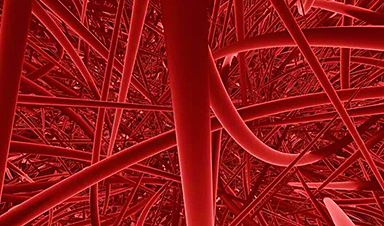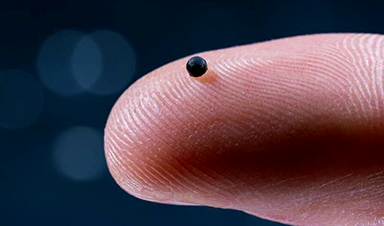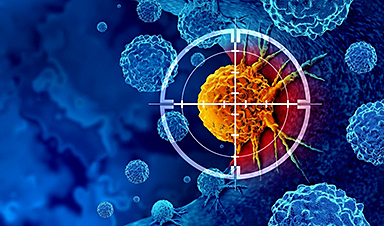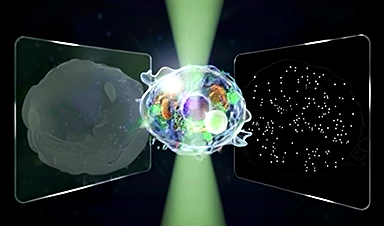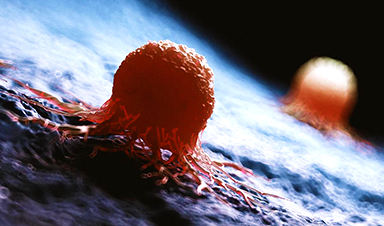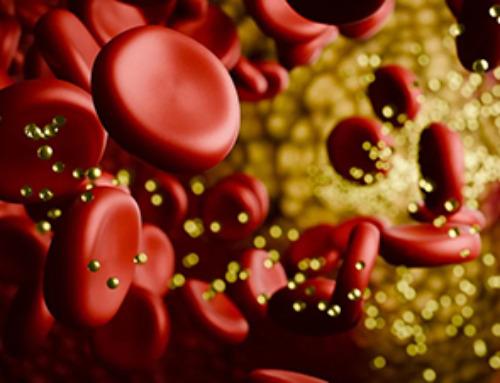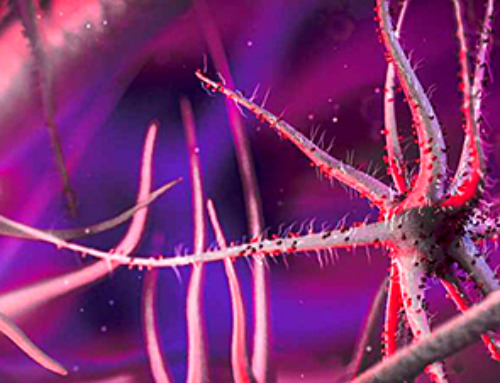Biological computing machines, such as micro and nano-implants that can collect important information inside the human body, are transforming medicine. Yet, networking them for communication has proven challenging. Now, a global team, including EPFL researchers, has developed a protocol that enables a molecular network with multiple transmitters.
“Overall, this is a very, very exciting research field,” explained Assistant Professor Haitham Al Hassanieh, head of the Laboratory of Sensing and Networking Systems in EPFL’s School of Computer and Communication Sciences (IC). “With advances in bio-engineering, synthetic biology, and nanotechnology, the idea is that nano-biosensors will revolutionize medicine because they can reach places and do things that current devices or larger implants can’t,” he continued.
Yet no matter how exciting this cutting-edge research field is, there remains a huge, fundamental challenge—when you have a nano-robot in someone’s body, how will you communicate with it? Traditional techniques, like wireless radios, work well for large implants such as pacemakers or defibrillators but can’t be scaled to micro and nano-dimensions, and wireless signals don’t penetrate through body fluids.
Enter what’s being called biomolecular communication, inspired by the body itself. It doesn’t utilize electromagnetic waves but biological molecules both as carriers and as information, mimicking the existing communication mechanisms in biology. In its simplest form it encodes “1” and “0” bits by releasing or not releasing molecular particles into the bloodstream—similar to ON-OFF-Keying in wireless networks.
“Biomolecular communication has emerged as the most suitable paradigm for networking nano-implants. It’s an incredible idea that we can send data by encoding it into molecules which then go through the bloodstream and we can communicate with them, guiding them on where to go and when to release their treatments, just like hormones,” Al Hassanieh said.
Recently, Al Hassanieh and his team, in collaboration with researchers in the United States presented their paper, “Towards Practical and Scalable Molecular Networks,” at ACM SIGCOMM 2023, an annual conference on Data Communication, in which they outlined their MoMA (Molecular Multiple Access) protocol that enables a molecular network with multiple transmitters.
“Most existing research is very theoretical and doesn’t work because the theories haven’t considered biology,” explained Al Hassanieh. “For example, every time the heart pumps there’s a jitter and the body changes its internal communication channel. Most existing theory assumes that the channel that you send the molecules over is very stable and doesn’t change. It actually changes very fast.”
With MoMA, the team introduced packet detection, channel estimation, and encoding/decoding schemes that leverage the unique properties of molecular networks to address existing challenges. They evaluated the protocol on a synthetic experimental testbed—emulated blood vessels with tubes and pumps—demonstrating that it can scale up to four transmitters while significantly outperforming state-of-the-art technology.
The researchers acknowledge that their current synthetic testbed may not capture all the challenges associated with designing protocols for molecular networks and that in-vivo testing of micro-implants and micro-fluids in wet-labs is needed to achieve practical and deployable molecular networks. However, they believe they have taken the first steps towards this vision and that their insights for designing molecular networks will hold, as the underlying diffusion and fluid dynamics models in their testbed are fundamental to molecular communication
“I am very excited about this area because it’s a new form of communication. We are a systems group, we like building things and getting them working. It’s taken time to develop the expertise we have in biomolecular communication but now we are at the stage where we are finding collaborators and can get things moving. People think this is science fiction but it’s fast moving to science fact,” Al Hassanieh concluded.
More information: Jiaming Wang et al, Towards Practical and Scalable Molecular Networks, Proceedings of the ACM SIGCOMM 2023 Conference (2023). DOI: 10.1145/3603269.3604881
News
Current Heart Health Guidelines Are Failing To Catch a Deadly Genetic Killer
New research reveals that standard screening misses most people with a common inherited cholesterol disorder. A Mayo Clinic study reports that current genetic screening guidelines overlook most people who have familial hypercholesterolemia, an inherited disorder that [...]
Scientists Identify the Evolutionary “Purpose” of Consciousness
Summary: Researchers at Ruhr University Bochum explore why consciousness evolved and why different species developed it in distinct ways. By comparing humans with birds, they show that complex awareness may arise through different neural architectures yet [...]
Novel mRNA therapy curbs antibiotic-resistant infections in preclinical lung models
Researchers at the Icahn School of Medicine at Mount Sinai and collaborators have reported early success with a novel mRNA-based therapy designed to combat antibiotic-resistant bacteria. The findings, published in Nature Biotechnology, show that in [...]
New skin-permeable polymer delivers insulin without needles
A breakthrough zwitterionic polymer slips through the skin’s toughest barriers, carrying insulin deep into tissue and normalizing blood sugar, offering patients a painless alternative to daily injections. A recent study published in the journal Nature examines [...]
Multifunctional Nanogels: A Breakthrough in Antibacterial Strategies
Antibiotic resistance is a growing concern - from human health to crop survival. A new study successfully uses nanogels to target and almost entirely inhibit the bacteria P. Aeruginosa. Recently published in Angewandte Chemie, the study [...]
Nanoflowers rejuvenate old and damaged human cells by replacing their mitochondria
Biomedical researchers at Texas A&M University may have discovered a way to stop or even reverse the decline of cellular energy production—a finding that could have revolutionary effects across medicine. Dr. Akhilesh K. Gaharwar [...]
The Stunning New Push to Protect the Invisible 99% of Life
Scientists worldwide have joined forces to build the first-ever roadmap for conserving Earth’s vast invisible majority—microbes. Their new IUCN Specialist Group reframes conservation by elevating microbial life to the same urgency as plants and [...]
Scientists Find a Way to Help the Brain Clear Alzheimer’s Plaques Naturally
Scientists have discovered that the brain may have a built-in way to fight Alzheimer’s. By activating a protein called Sox9, researchers were able to switch on star-shaped brain cells known as astrocytes and turn them into [...]
Vision can be rebooted in adults with amblyopia, study suggests
Temporarily anesthetizing the retina briefly reverts the activity of the visual system to that observed in early development and enables growth of responses to the amblyopic eye, new research shows. In the common vision [...]
Ultrasound-activated Nanoparticles Kill Liver Cancer and Activate Immune System
A new ultrasound-guided nanotherapy wipes out liver tumors while training the immune system to keep them from coming back. The study, published in Nano Today, introduces a biodegradable nanoparticle system that combines sonodynamic therapy and cell [...]
Magnetic nanoparticles that successfully navigate complex blood vessels may be ready for clinical trials
Every year, 12 million people worldwide suffer a stroke; many die or are permanently impaired. Currently, drugs are administered to dissolve the thrombus that blocks the blood vessel. These drugs spread throughout the entire [...]
Reviving Exhausted T Cells Sparks Powerful Cancer Tumor Elimination
Scientists have discovered how tumors secretly drain the energy from T cells—the immune system’s main cancer fighters—and how blocking that process can bring them back to life. The team found that cancer cells use [...]
Very low LDL-cholesterol correlates to fewer heart problems after stroke
Brigham and Women's Hospital's TIMI Study Group reports that in patients with prior ischemic stroke, very low achieved LDL-cholesterol correlated with fewer major adverse cardiovascular events and fewer recurrent strokes, without an apparent increase [...]
“Great Unified Microscope” Reveals Hidden Micro and Nano Worlds Inside Living Cells
University of Tokyo researchers have created a powerful new microscope that captures both forward- and back-scattered light at once, letting scientists see everything from large cell structures to tiny nanoscale particles in a single shot. Researchers [...]
Breakthrough Alzheimer’s Drug Has a Hidden Problem
Researchers in Japan found that although the Alzheimer’s drug lecanemab successfully removes amyloid plaques from the brain, it does not restore the brain’s waste-clearing system within the first few months of treatment. The study suggests that [...]
Concerning New Research Reveals Colon Cancer Is Skyrocketing in Adults Under 50
Colorectal cancer is striking younger adults at alarming rates, driven by lifestyle and genetic factors. Colorectal cancer (CRC) develops when abnormal cells grow uncontrollably in the colon or rectum, forming tumors that can eventually [...]
